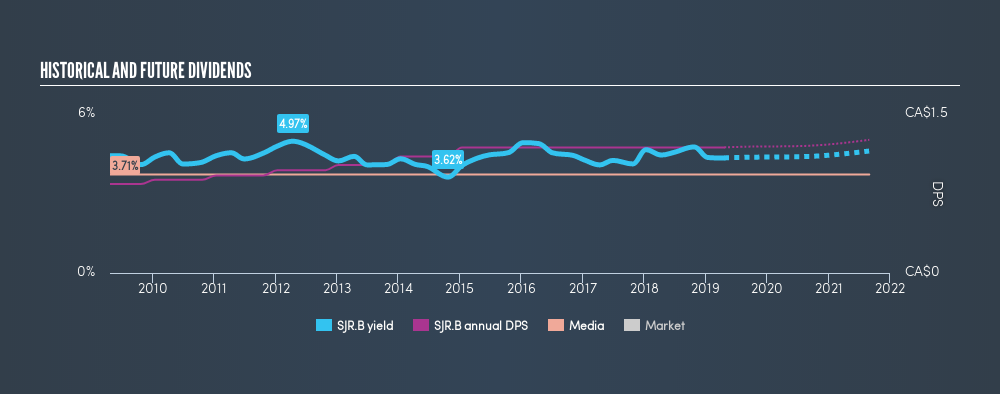Consider This Before Buying Shaw Communications Inc. (TSE:SJR.B) For The 4.3% Dividend

Today we'll take a closer look at Shaw Communications Inc. (TSE:SJR.B) from a dividend investor's perspective. Owning a strong dividend company and reinvesting the dividends is widely seen as an attractive way of growing your wealth. Unfortunately, one common occurrence with dividend companies is for investors to be enticed in by the seemingly attractive yield, and lose money when the company has to cut its dividend payments.
In this case, Shaw Communications likely looks attractive to investors, given its 4.3% dividend yield and a payment history of over ten years. It's likely that plenty of investors have purchased it for the income. When buying stocks for their dividends, you should always run through the checks below, to see if the dividend looks sustainable.
Explore this interactive chart for our latest analysis on Shaw Communications!
Payout ratios
Dividends are usually paid out of company earnings. If a company is paying more than it earns, then the dividend might become unsustainable - hardly an ideal situation. So we need to be form a view on if a company's dividend is sustainable, relative to its net profit after tax. In the last year, Shaw Communications paid out 131% of its profit as dividends. A payout ratio above 100% is definitely an item of concern, unless there are some other circumstances that would justify it.
In addition to comparing dividends against profits, we should inspect whether the company generated enough cash to pay its dividend. Shaw Communications paid out 167% of its free cash last year. Cash flows can be lumpy, but paying out this much cash is not ideal. Paying out more than 100% of your free cash flow in dividends is generally not a long-term, sustainable state of affairs, so we think shareholders should watch this metric closely.
Is Shaw Communications's Balance Sheet Risky?
As Shaw Communications's dividend was not well covered by earnings, we need to check its balance sheet for signs of financial distress.A rough way to check this is with these two simple ratios: a) net debt divided by EBITDA (earnings before interest, tax, depreciation and amortisation), and b) net interest cover. Net debt to EBITDA measures a company's total debt load relative to its earnings (lower = less debt), while net interest cover measures the company's ability to pay the interest on its debt (higher = greater ability to pay interest costs). Shaw Communications has net debt of less than two times its earnings before interest, tax, depreciation, and amortisation (EBITDA), which we think is not too troublesome.
Net interest cover can be calculated by dividing earnings before interest and tax (EBIT) by the company's net interest expense. Interest cover of less than 5x its interest expense is starting to become a concern for Shaw Communications, and be aware that lenders may place additional restrictions on the company as well.
We update our data on Shaw Communications every 24 hours, so you can always get our latest analysis of its financial health, here.
Dividend Volatility
One of the major risks of relying on dividend income, is the potential for a company to struggle financially and cut its dividend. Not only is your income cut, but the value of your investment declines as well - nasty. Shaw Communications has been paying dividends for a long time, but for the purpose of this analysis, we only examine the past 10 years of payments. During this period the dividend has been stable, which could imply the business could have relatively consistent earnings power. During the past ten-year period, the first annual payment was CA$0.84 in 2009, compared to CA$1.19 last year. Dividends per share have grown at approximately 3.5% per year over this time.
Dividend Growth Potential
Dividend payments have been consistent over the past few years, but we should always check if earnings per share (EPS) are growing, as this will help maintain the purchasing power of the dividend. In the last five years, Shaw Communications's earnings per share have shrunk at approximately -11% per annum. Declining earnings per share over a number of years is not a great sign for the dividend investor. Without some improvement, this does not bode well for the long term value of a company's dividend.
Conclusion
When we look at a dividend stock, we need to form a judgement on whether the dividend will grow, if the company is able to maintain it in a wide range of economic circumstances, and if the dividend payout is sustainable. We're a bit uncomfortable with Shaw Communications paying out a high percentage of both its cashflow and earnings. Second, earnings per share have actually shrunk, but at least the dividends have been relatively stable. Using these criteria, Shaw Communications looks quite suboptimal from a dividend investment perspective.
Without at least some growth in earnings per share over time, the dividend will eventually come under pressure either from costs or inflation. See if the 14 analysts are forecasting a turnaround in our free collection of analyst estimates here.
Looking for more high-yielding dividend ideas? Try our curated list of dividend stocks with a yield above 3%.
We aim to bring you long-term focused research analysis driven by fundamental data. Note that our analysis may not factor in the latest price-sensitive company announcements or qualitative material.
If you spot an error that warrants correction, please contact the editor at editorial-team@simplywallst.com. This article by Simply Wall St is general in nature. It does not constitute a recommendation to buy or sell any stock, and does not take account of your objectives, or your financial situation. Simply Wall St has no position in the stocks mentioned. Thank you for reading.
About TSX:SJR.B
Shaw Communications
Shaw Communications Inc. operates as a connectivity company in North America.
Established dividend payer with questionable track record.
Similar Companies
Market Insights
Community Narratives



